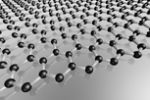EPJ B Highlight - Graphene nanoribbons as electronic switches
- Details
- Published on 31 March 2014

A new theoretical study shows the conductivity conditions under which graphene nanoribbons can become switches in externally controlled electronic devices
One of graphene’s most sought after properties is its high conductivity. Argentinian and Brazilian physicists have now successfully calculated the conditions of the transport, or conductance mechanisms, in graphene nanoribbons. The results, recently published in a paper in EPJ B, yield a clearer theoretical understanding of conductivity in graphene samples of finite size, which have applications in externally controlled electronic devices.
When the conductivity is high the electrons, carriers of electrical current, are minimally hampered during transport through graphene. One aspect of conductivity is the electron transport gap, which is the minimal energy required for electric current to pass through the material. The electron transport gap is an important factor for applications in electronic devices, because when the transport gap is controllable, it can be used as a switch in transistors – the main components of any electronic device.
To study the electron transport gap, scientists prefer to use graphene nanoribbons, which can have variable crystallographic structures at their edges. In this EPJ B paper, the authors found that the transport gap is larger when the ribbon is narrower in width and that it is independent of the crystallographic orientation of the ribbon’s edges.
The team found that the transport gap is inversely proportional to the ribbon’s width and is independent of the crystallographic orientation of the ribbon’s edges. Also, the conductance varies with the applied external voltage. These findings confirm previous theoretical and experimental results.
In addition, the authors focused on direct current conductivity, which is expected to jump through well-defined sharp steps, and referred to as quantisation. However, the authors’ theoretical models present a somewhat different picture: the steps are not equally spaced and are not clearly separate but more blurred. By comparison, the conductance quantisation in graphene nanoribbons was previously observed experimentally in several works.
Unfortunately, none of the experiments can yet resolve the form of the steps. Further, the precision of existing measurements cannot yet clearly discriminate between different predictions for quantisation. More precise theoretical models are now required for a better understanding of the experimental behaviour of nanoribbons.
C. G. Beneventano, I. V. Fialkovsky, E. M. Santangelo and D. V. Vassilevich (2014), Charge density and conductivity of disordered Berry-Mondragon graphene nanoribbons , European Physical Journal B, DOI 10.1140/epjb/e2014-40990-x




